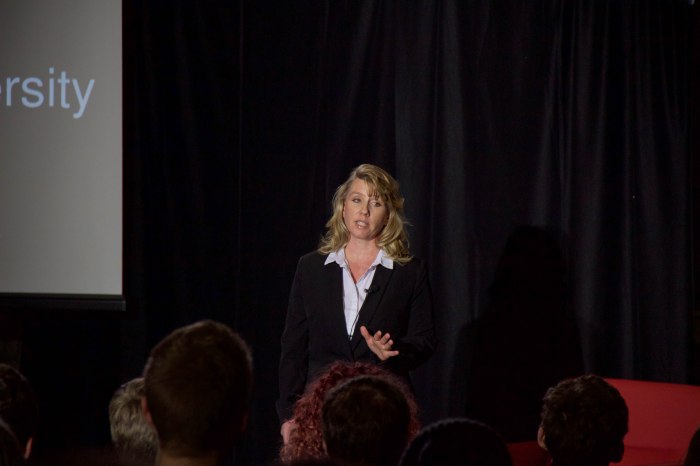
Recently, we were invited to present a TEDx talk wherein we posed a “What if…?” question. Our question was, “What if sexual assault self protection could be nonviolent?” (A video of the talk can be found here.)
As is the case with TED talks in general, our goal was to transcend conventional thinking and, in our case, reimagine a solution to a pressing problem. Because we have been developing and testing an integrated set of scientifically-grounded responses to sexual assault that include nonviolent options, we jumped at the opportunity to share that perspective and a very small sampling of these nonviolent responses with a larger audience.
As one might expect, new solutions to old problems bring a mixture of reactions, even if those solutions are demonstrably effective. A great many people were enthusiastic and supportive, and appreciated the fresh approach. A small minority shared skepticism and even hatred, comparing a nonviolent, self-protective solution to “victim shaming,” and openly criticizing the message as “pathetic,” “ridiculous,” “disgusting,” and suggesting that we should “become pen pals with child molesters.”
This is not the first time that this approach has been attacked. (Indeed, we received an angry message within the first months of the program’s development from a person who was disgusted that Elemental was specifically inclusive of the needs of sexual minorities.) We have addressed the victim blaming argument in a previous post, as have other authors. Reasonable skepticism is healthy, and we always welcome the opportunity to present our evidence. The vitriolic response is another matter, and it could easily be dismissed as the irrational, knee-jerk reactions of a person who carries a great deal of pain inside.
We disagree that dismissiveness is the best approach, however, because every experience has the potential to take us to an improved understanding. This experience reminds us of three things:
(1) It is common to cling to the belief that all violence must be met with violence of equal or greater magnitude in order for a response to be effective in ending the initial violence. Although violence may ultimately end violence in some cases, nonviolent tactics have also been an effective tool against violence and subjugation in other contexts (e.g., the civil rights movement, Indian independence). The evidence we have suggests that it can be effective for people faced with awkward or dangerous and sexually charged situations, too. Both violence and nonviolence can work. Whether students pick a violent solution, a nonviolent solution, or start with one and transition to the other is not up to program administrators or instructors. It is up to the people who face such situations every day. We give them choices. They select based on what they believe is best for them.
(2) It is common to have great difficulty imagining that other people would have responded differently than oneself. This has much to do with the bubble of personal experience that encloses each of us. Our colleagues in psychology remind us that people tend to assume that others experience the world as they do, subject to the same inputs and same priorities in making decisions. This leads us to imagine that others agree with our conclusions, and often we are surprised when they do not. One of the jobs of good science is to transcend that bubble and, ultimately, to give credence to the lives of those who experience the world differently from ourselves. In our case, this means presenting solutions that work for people who have different backgrounds and who come to different conclusions about their contexts and relationships, what they hope to achieve when faced with challenging situations, and how they wish to go about achieving those goals. Understanding this variety requires that we engage in study—an “ology” (e.g., sociology, psychology, anthropology). Ignoring evidence from a broader world while simultaneously claiming that the solution one prefers for oneself should be imposed upon others crosses a dangerous border. Therefore, the choice of a violent solution, a nonviolent solution, or some combination thereof is therefore also not a decision of a peer (survivor or otherwise), a political movement, or a collection of outside adherents to a particular belief system. It is up to the people who face such situations every day, within the context of their roles, their relationships, and their realities.
(3) It is common to have a limited understanding of the great variety of contexts and situations that fall under a single label (in this case, “rape” or “sexual assault”). The common denominator for these labels is that unwanted (or nonconsensual) sexual contact or activity is involved. Beyond this, the tactics, motivations, goals, differences is size and strength, relationship combinations, and other contextual factors can and do vary tremendously. It could involve an angry or sadistic stranger; it is more likely to be an acquaintance or friend. It is often an intentional violation of trust by someone who wants power, but it may evolve from poor communication and inexperience. These expectations set the stage for different reactions from those who experience these situations and tend to require different kinds of preparation. This, in combination with the misunderstandings noted in point (2), further complicates the responses that come from a well-meaning public, including some of those who have experienced an assault. Because assaults span such a wide spectrum, it is beneficial not to assume that any one particular assault matches the default in one’s imagination. An outside observer must therefore approach the question of whether a particular solution would or would not “work” in any specific circumstance with great care. Again, this is why it is important to provide a spectrum of potentially effective choices—and to refrain from passing judgment on those who take a path that we ourselves might not.
~The Directors